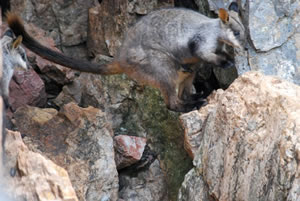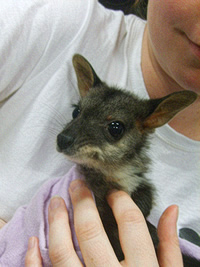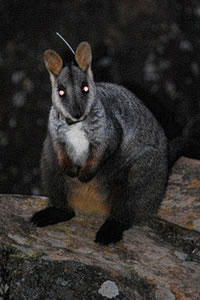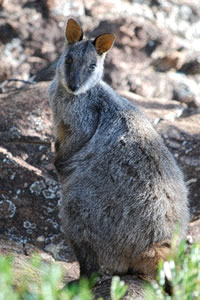Families
 Photo: Katherine Tuft
Photo: Katherine TuftBrush-tailed Rock-wallabies are highly territorial over their home range, which can be around 15 hectares
They are social macropods and live in family groups consisting of two to five adults plus juveniles and joeys. Within a colony, individual wallabies may share a single refuge site, except for adult males which behave aggressively when in contact with each other.
 Photo: Ryan Collins
Photo: Ryan CollinsJoeys
Females give birth to one joey at a time, after a gestation period of about 30 days. The young remain in the pouch for six months.
After the joey first emerges from the pouch it spends another one to three weeks in and out of the pouch. Male joeys move to a vacant area within the colony or leave the colony completely. Female joeys either move or remain and breed in their birth colony.
Sexual maturation occurs 18-24 months for females and 24 – 36 months for males. Males are polygamous meaning they father the offspring of several females. Females are usually monogamous, meaning they continuously mate with a single male until he is no longer available, then they will switch to another male.
 Photo: Katherine Tuft
Photo: Katherine TuftFood
Brush-tailed Rock-wallabies appear to have a broad diet that is seasonally flexible yet selective. They look for food mostly in the early morning or evening and feed on a combination of native forbs, grasses, shrubs, and ground cover plants, as well as fruits, roots and bark of shrubs and trees. They typically commute from the refuge or protected habitat on dusk, arriving at the feeding area within 30 minutes after sunset, and returning to the refuge habitat before dawn.
 Photo: Katherine Tuft
Photo: Katherine TuftHopping around
A few individual Brush-tailed Rock-wallabies, usually male, move successfully between colonies. Whether dispersal is successful is influenced by the distance between colonies and the nature of the intervening habitat (wallabies are more prone to predation in open grasslands).
More research is needed to identify the factors that are associated with habitat through which animals can move successfully, such as, the difference of movement between healthy populations and isolated colonies on the verge of extinction.
State Information
What you can do!
An important aspect of Brush-tailed Rock-wallaby recovery is the active involvement of local landholders and the community overall. See what you can do!
Resources
- Vortex Project Brief
- The Shadow – Newsletter of Brush-tailed Rock-wallaby conservation in Victoria
Did you know?
Rock-wallabies aren’t found anywhere else on earth. There are 16 species of rock-wallaby and they form the largest group of macropods (marsupial with large hind limbs) in Australia.






